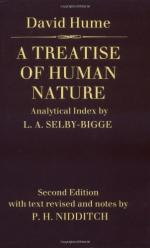When any affection is infused by sympathy, it is at first known only by its effects, and by those external signs in the countenance and conversation, which convey an idea of it. This idea is presently converted into an impression, and acquires such a degree of force and vivacity, as to become the very passion itself, and produce an equal emotion, as any original affection. However instantaneous this change of the idea into an impression may be, it proceeds from certain views and reflections, which will not escape the strict scrutiny of a. philosopher, though they may the person himself, who makes them.
It is evident, that the idea, or rather impression of ourselves is always intimately present with us, and that our consciousness gives us so lively a conception of our own person, that it is not possible to imagine, that any thing can in this particular go beyond it. Whatever object, therefore, is related to ourselves must be conceived with a little vivacity of conception, according to the foregoing principles; and though this relation should not be so strong as that of causation, it must still have a considerable influence. Resemblance and contiguity are relations not to be neglected; especially when by an inference from cause and effect, and by the observation of external signs, we are informed of the real existence of the object, which is resembling or contiguous.
Now it is obvious, that nature has preserved a great resemblance among all human creatures, and that we never remark any passion or principle in others, of which, in some degree or other, we may not find a parallel in ourselves. The case is the same with the fabric of the mind, as with that of the body. However the parts may differ in shape or size, their structure and composition are in general the same. There is a very remarkable resemblance, which preserves itself amidst all their variety; and this resemblance must very much contribute to make us enter into the sentiments of others; and embrace them with facility and pleasure. Accordingly we find, that where, beside the general resemblance of our natures, there is any peculiar similarity in our manners, or character, or country, or language, it facilitates the sympathy. The stronger the relation is betwixt ourselves and any object, the more easily does the imagination make the transition, and convey to the related idea the vivacity of conception, with which we always form the idea of our own person.
Nor is resemblance the only relation, which has this effect, but receives new force from other relations, that may accompany it. The sentiments of others have little influence, when far removed from us, and require the relation of contiguity, to make them communicate themselves entirely. The relations of blood, being a species of causation, may sometimes contribute to the same effect; as also acquaintance, which operates in the same manner with education and custom; as we shall see more fully [Part II. Sect. 4.] afterwards. All these relations, when united together, convey the impression or consciousness of our own person to the idea of the sentiments or passions of others, and makes us conceive them in the strongest and most lively manner.




